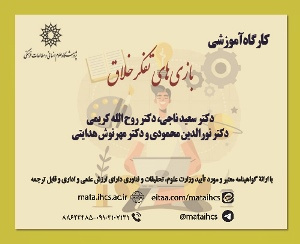بررسی انتقادی کتاب کاربردشناسی واژگانی و نظریۀ ذهن: فراگیری پیوندها (مقاله علمی وزارت علوم)
درجه علمی: نشریه علمی (وزارت علوم)
آرشیو
چکیده
این مقاله به بررسی و نقد ترجمۀ کتاب کاربردشناسی واژگانی و نظریۀ ذهن: فراگیری پیوندها نوشتۀ سندرین زوفری و ترجمۀ محمدحسن ترابی، شهره صادقی و الهه کمری می پردازد. نظریۀ ذهن یکی از مهم ترین حوزه های مطالعاتی در روان شناسی شناختی است که توانایی افراد در درک حالات ذهنی خود و دیگران را مورد بررسی قرار می دهد. این کتاب با رویکردی میان رشته ای سعی دارد جوانب مختلف رابطۀ نظریۀ ذهن و کاربردشناسی زبان را بکاود. در این مقاله، کتاب از منظر ساختاری و شکلی و نیز محتوایی مورد بررسی قرار گرفته است. از نقاط قوت کتاب می توان به ترجمۀ بسیار روان و خوش خوان، دقت قابل قبول ترجمه، پانویسی اصطلاحات تخصصی و اسامی خاص، واژه نامۀ دوزبانه، و رعایت اصول ویرایشی اشاره کرد. از کاستی های کتاب نیز می توان عدم یکدستی برخی معادل های به کاررفته در کتاب، ضعف و کم دقتی در صحافی، و برخی خطاهای املایی و دستوری را برشمرد. در مجموع، کلیّت کتاب به دلیل پرداختن به موضوعی بدیع و برخورداری از ترجمه ای خوب و روان مثبت ارزیابی می شود و می تواند منبعی ارزشمند برای پژوهشگران فارسی زبان جهت انجام تحقیقات میان رشته ای در حوزه های زبان و نظریۀ ذهن باشد.متن
A Critical Review on the Book “Lexical Pragmatics and Theory of Mind: The Acquisition of Connectives”
This article presents a critical review of the Farsi translation of the book “ Lexical Pragmatics and Theory of Mind: The Acquisition of Connectives” authored by Sandrine Zufferey. Theory of Mind is one of the most important research areas within the domain of cognitive psychology that studies humans’ abilities in understanding mental states of themselves and others. The book takes a multidisciplinary approach to explore different aspects of pragmatics and Theory of Mind interface. In the present article, the translated book was evaluated in terms of structure, form, and content. Merits of the book include: having a fluent and readable translation, acceptable precision of translation, footnoting technical terms and proper names, having bilingual glossaries, and acceptable editing. On the other hand, inconsistent use of equivalents, inconsistent print quality and poor bookbinding, and the existence of typographical and grammatical errors are among the shortcomings of the book. Overall, by introducing a novel area and offering a fluent translation, the book is evaluated positively. It can be an invaluable resource for Persian speaking researchers for doing interdisciplinary research at the interface of language and Theory of Mind.





